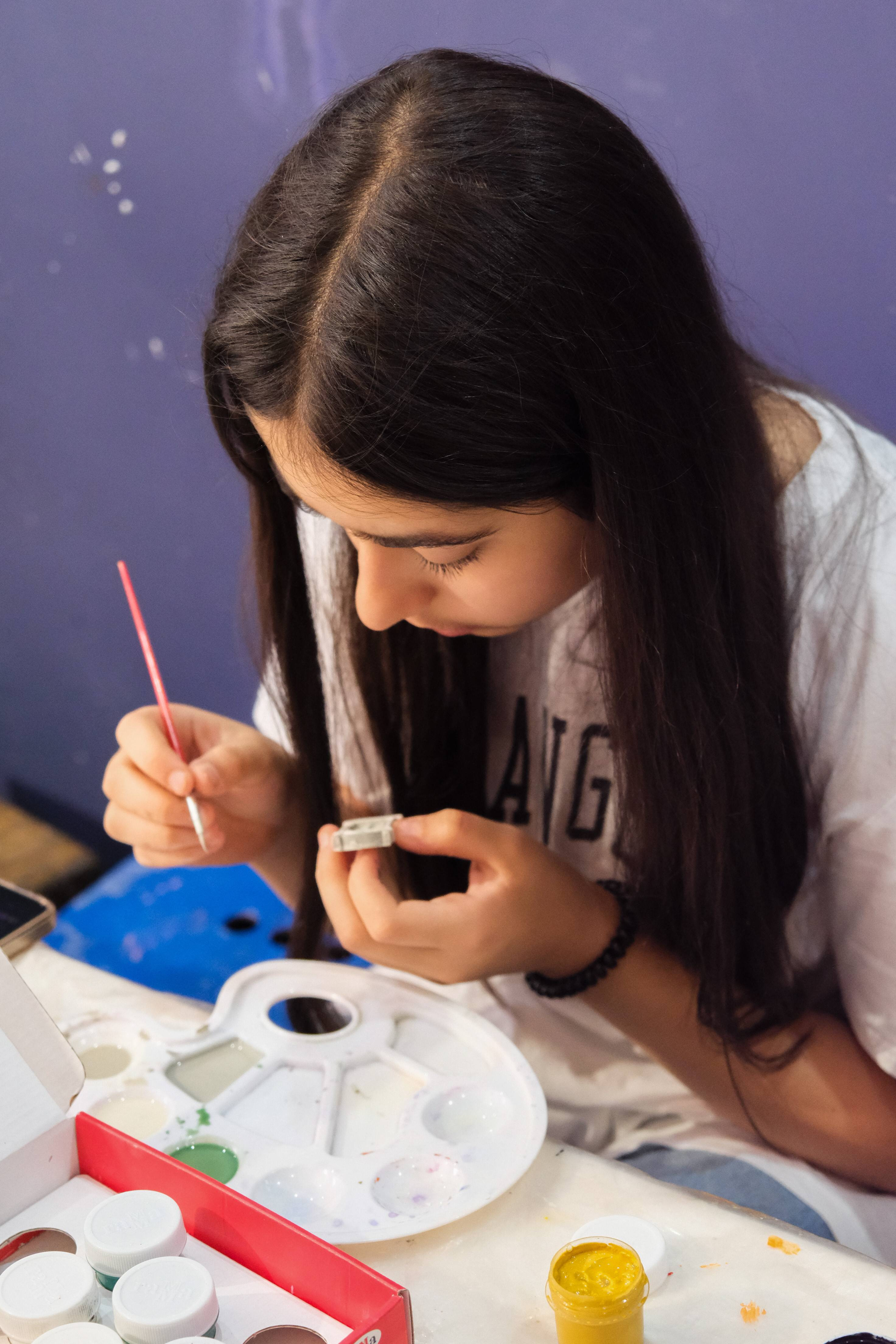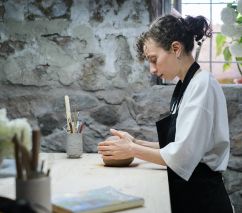Interview | Varem-Marem: Revamping Gyumri’s Art Scene
November 13, 2024
The cultural capital of Armenia, Gyumri, is home to Varem-Marem, a tourist favorite spot, both a gift shop and an art studio. In this exclusive interview with h-pem, its founder Mikayel Vardparonyan shares the story of how Varem-Marem came to be, its collection of memories, and how a stray dog became the mascot of their store.
Wandering through the old city streets, you slowly discover houses tucked into the hills and scattered remnants of the 1988 earthquake. From afar, a balcony stirs a distant memory. “Varem, marem, Varem-Marem,” calls a familiar refrain, drawing you closer. You’re soon greeted by a scruffy, chocolate-brown dog with the kindest eyes and adorably short legs—a heart of gold on four stumpy paws. He guides you to a magical wall covered in countless names, vibrant and lively, leading you to Varem-Marem, an art studio and gift shop in Gyumri, Armenia, that’s not to be missed.
In this exclusive interview with h-pem, founder Mikayel Vardparonyan shares the story behind Varem-Marem’s beginnings, its trove of cherished memories, and how Aslan the dog became a beloved icon of Gyumri.
I walk by clusters of families gathered around the vibrant crossword wall, squinting against the August sun as they search for the perfect spot to spell out their names. A boy emerges from Varem-Marem, a glue gun slung over his shoulder, ready to fix ceramic letters in place. Moments later, a girl follows with a paintbrush and palette in hand, calling out, “Mher, did you spell it right? Step back a bit so we can see your name!” An iPhone clicks as Mher, a visitor, carefully paints the final letter, then turns with a proud smile for a photo.
Inside, I’m greeted by Mikayel Vardparonyan, Varem-Marem’s founder, who’s eager to start our conversation. We step into the main room of the studio and gift shop, where more lively exchanges unfold. I spot a sticker set from their store featuring the studio’s mascot, Aslan—the dog who greeted me outside. His likeness appears on postcards, sprawled in a “rub my belly” pose, sitting alert by the crossword wall, and in a sticker collection capturing his many moods. I can’t help but smile as I search for that familiar tuft of fur, already thinking of my first question.
.jpg)
Lilit Davtyan: What’s the story behind Aslan the dog? How did he become Varem-Marem’s PR manager?
Mikayel Vardparonyan: When we were getting ready to open the Varem-Marem Art Studio, we opened the doors to our future space, and the first to walk in was Aslan. From that moment, he became a cherished member of our team and a symbol of the studio. Aslan loved having his photo taken, so we started featuring him in pictures on the iconic balcony from The Tango of Our Childhood with all our visitors. This led us to create an Instagram page just for him. Over time, Aslan gained quite a following, appeared on various TV programs, and became Armenia’s most famous stray dog. Today, through his Instagram, he continues to promote our art gallery.
LD: How did Varem-Marem come to be? What inspired you to start the workshops?
MV: My grandfather was a distinguished painter during the Armenian Soviet era, and as a child, I spent most of my days in his studio. After exploring different art fields over the years, I decided to open a new chapter and create a space that reflects my passion—a place where people can immerse themselves in hands-on art experiences. In a city celebrated for its arts and crafts, there wasn’t yet a place where people could participate in workshops, so we wanted to offer that. Our goal is to let visitors not only view art but also engage in creating their own.
LD: Varem-Marem is known for its iconic magnets, like those inspired by “The Tango of Our Childhood” and the famous doors of Gyumri. How did these ideas come about?
MV: Since our studio is located right in front of the famous balcony from The Tango of Our Childhood, we wanted to create souvenirs inspired by it. Gyumri is also famous for its beautiful old wooden doors, and we wanted to capture their charm so visitors could take a piece of that beauty home. These souvenirs are a meaningful way to celebrate Gyumri and share its unique heritage.
.png)
LD: What is the meaning behind your business name, Varem-Marem?
MV: The name Varem-Marem has three layers of meaning. First, it’s a reference to a famous scene from The Tango of Our Childhood. It also relates to the transformation process in ceramics, where the Armenian words "վառել" (varel, meaning “to ignite”) and "մարել" (marel, meaning “to extinguish”) describe the firing of clay in a kiln. Lastly, our goal is to “ignite” our visitors’ creative ideas, providing them with a space where they can bring their imaginative concepts to life.
As we spoke, a constant chant of “Varem-Marem, Varem-Marem” echoed in the distance, followed by a bittersweet melody. The street, filled with tourists snapping photos and posing by Gyumri’s latest cultural landmark, felt like a scene plucked directly from an iconic Armenian film. It brought back memories of my own, of Hollywood Blvd, where, in my childhood, I’d often wander—a short metro ride from my apartment in Little Armenia, Los Angeles. I remember walking along the Hollywood Walk of Fame, eyes on the pavement to avoid the horror mascots roaming the streets, like Chucky the Doll or Freddy Krueger. Tourists flooded the street, pressing close to tour buses and gazing out at a scene equally magical and surreal, an atmosphere created by the perfect blend of every element.
I never would have imagined a similar street in Armenia—one so inseparable from its cinematic past and now a bustling tourist destination. Both streets invite interaction: here, you press clay tiles into the crossword wall winding down the street; there, you press your hands into the impressions of Hollywood icons. And in Gyumri, this street has taken on a life of its own, drawing people worldwide. Standing across from the crossword wall, it was surreal to think that one of the most famous scenes in Armenian cinema history was filmed on that very balcony. Though Galya Novents’ voice echoed the memory through song, it took a moment to truly envision Frunzik Mkrtchyan walking these streets.
.jpg)
LD: What’s the story behind the crossword wall? How does it feel to see its growing popularity, and what will happen when the wall is completely covered?
MV: Originally, we wanted to promote our art studio by placing letters around the city, but without a way to monitor them, many letters were broken or removed. So, we decided to secure the letters on the wall of our art studio instead. We started with the names of our team members, and soon visitors wanted to add their own names too—that’s how the crossword wall project took off. Since then, over 50,000 people, including renowned musicians, politicians, singers, and actors, have left their mark. It’s been a long journey, and the vision is to stretch out to the end of the street, eventually moving in different directions. Once we’ve completed this phase, we’ll start planning the next chapter.
LD: What’s your favorite moment you’ve witnessed from a visitor? What are tourists most curious about?
MV: One of our favorite moments was when Serj Tankian from System of a Down, a band our whole team admires, visited our art studio during the COVID-19 pandemic. He was wearing a mask, glasses, and a hat, so we didn’t recognize him at first. As usual, we invited him and his family to explore the space, unaware we were hosting the famous Armenian rock star. Then, during our conversation, he took off his hat, glasses, and mask, and we were stunned—it was an incredible surprise! The wall also has signatures from other notable visitors, like Tigran Tsitoghdzyan, world champion athletes, ambassadors, politicians, singers, actors, and, of course, thousands of beloved visitors from around the world.
(2).png)
Mikayel led me to their extended workshop room—a spacious area with a gallery and workstations where a team member was busy painting Gyumri door magnets. Gyumri is a city defined not only by its vibrant arts scene but also by its unique doors and preserved architecture, a rarity in Armenia. Rather than modernizing the cityscape, they focus on maintaining what gives Gyumri its distinctive charm, hence the magnets and merchandise inspired by these historic doors and an iconic local film. I even got a sneak peek at their hidden coffee booth, where the barista sketches each customer’s portrait on their coffee cup. Watching guests' eyes dart nervously, awaiting their mini-portrait, was delightful—each cup sparking a moment of surprise and joy.
We eventually settled in the office to continue our conversation, joined by Aslan, who knew exactly where to find us. Mikayel asked about my familiarity with Gyumri’s history, and I confessed I only knew the basics. He opened a book on the table to reveal photos of Gyumri before and after the 1988 earthquake. Although I was aware of the earthquake’s devastation—my own family immigrated after it affected another Armenian city, Vanadzor—I had never seen such direct before-and-after images. The impact was heartbreaking. "They worked on restoring the buildings for only about two years, and then we were left on our own. Many parts of Gyumri remain as remnants of the ruins,” he explained. It was surreal to realize how the earthquake continued to define Gyumri decades later.
Gyumri has changed names four times—from Kumayri to Alexandrapol, Leninakan, and finally Gyumri—but its soul has remained intact. Mikayel’s mission is to recapture and revive that original charm, and the influx of visitors from around the world, speaking languages like English, Armenian, and Mandarin, suggests he’s succeeding.
LD: How does it feel to be one of Gyumri’s gems and a must-visit destination? How do you hope to expand your business and outreach?
MV: Over the past three years, we’ve worked tirelessly, without weekends or holidays, keeping our doors open 365 days a year. Maintaining our status as a must-visit place is challenging, but the energy we receive from each new visitor keeps us motivated. We’re passionate about what we do and truly enjoy our work. Our art studio attracts nearly 200,000 to 300,000 visitors annually, and we strive to engage with each one, creating entertaining and memorable experiences. In terms of future growth, we’re considering franchising in different cities across Armenia and even exploring opportunities in various corners of the world.
LD: Since your involvement with Artbox, how has your business progressed? What aspects have you seen the most improvement in?
MV: Participating in Artbox by Creative Armenia was a fantastic opportunity for us, especially since we initially lacked extensive knowledge in business management. Working with exceptional mentors from various global organizations was invaluable. Throughout the project, we were able to bring new experts onto our team, leading to exciting collaborations for our art studio. We’re also acquiring new technical equipment to expand our studio's offerings.
LD: What classes or workshops do you dream of adding in the future?
MV: We frequently host musicians who perform small concerts at our art studio, so we’re eager to incorporate a musical element in the near future. Adding a dedicated music corner would be a fantastic enhancement, and we plan to offer musical masterclasses as part of our new features. You can stay updated on Varem-Marem’s upcoming workshops, events, and Aslan’s antics through their social media pages.
Join our community and receive regular updates!
Join now!






















Attention!